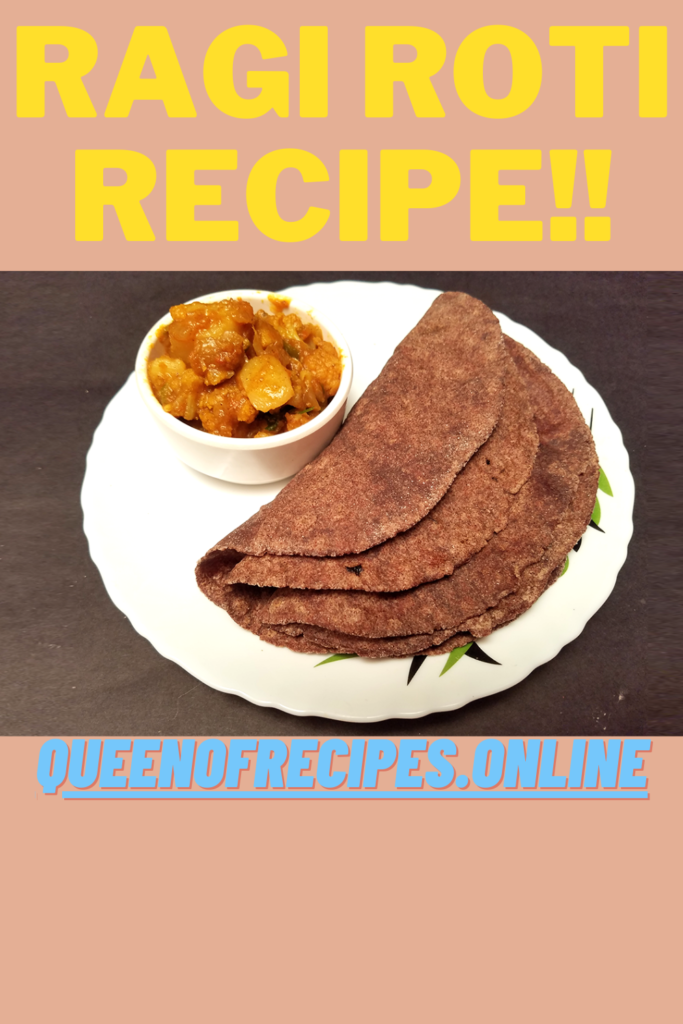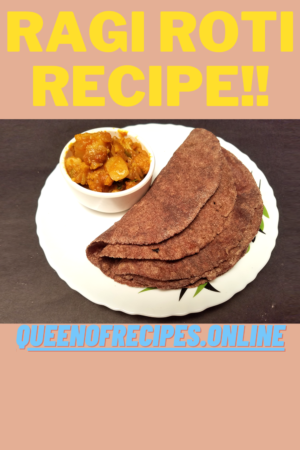Table of Contents
About Ragi Roti.
Ragi Roti, also known as Finger Millet Flatbread, is a wholesome and nutritious Indian dish that hails from the southern regions of India, particularly Karnataka. Ragi, or finger millet, is a highly nutritious grain known for its exceptional health benefits. It is a popular way to incorporate this superfood into the diet.
This flatbread is made from ragi flour, often mixed with other ingredients like finely chopped vegetables, herbs, and spices. The dough is hand-pressed into thin, round discs and cooked on a griddle until it becomes golden and slightly crispy. Ragi Roti boasts a distinct earthy flavor with a hint of nuttiness, making it a unique and flavorful addition to Indian cuisine.
What sets Ragi Roti apart is its nutritional profile. Ragi is rich in essential nutrients, including dietary fiber, calcium, iron, and antioxidants. This makes it not only a delicious culinary experience but also a wholesome and healthy choice. It’s particularly favored among those seeking gluten-free options, as ragi is naturally gluten-free.
In this article, we will explore the preparation and variations of Ragi Roti, its health benefits, and the delightful ways it can be enjoyed as a part of a balanced diet. Whether served with chutneys, curries, or yogurt, it offers a satisfying and nutritious meal that reflects the diversity and richness of Indian cuisine.
Homemade Ragi Roti Recipe
Making Ragi Roti at home is a simple and nutritious process. This recipe yields approximately 6-8 rotis.
Ingredients:
- 1 cup ragi flour (finger millet flour)
- 1/4 cup finely chopped onions
- 1/4 cup finely chopped spinach or other greens (optional)
- 1-2 green chilies, finely chopped (adjust to your spice preference)
- 1/4 teaspoon cumin seeds
- Salt to taste
- Warm water for kneading (approximately 1/2 cup)
- Oil or ghee for cooking
Instructions:
- Prepare the Dough:
- In a mixing bowl, combine the ragi flour, chopped onions, green chilies, chopped greens (if using), cumin seeds, and a pinch of salt.
- Gradually add warm water to the mixture and begin kneading the dough. Keep adding water until you achieve a soft, pliable, and non-sticky dough. It should hold together but not be too dry or too wet.
- Divide into Balls:
- Divide the dough into small, lemon-sized balls. These will be used to make individual rotis.
- Flatten the Rotis:
- Take a ball of dough and place it on a clean, flat surface like a rolling board or a silicone baking mat.
- Gently flatten the ball using your fingers, spreading it out evenly to form a thin, round roti. You can also use a rolling pin for this step, dusting it with a little ragi flour to prevent sticking.
- Cook on a Griddle:
- Heat a griddle or a non-stick pan over medium-high heat. Once hot, place the flattened ragi roti on the griddle.
- Cook for a minute or two until you see small bubbles forming on the surface. Then, flip it over using a spatula.
- Apply Oil or Ghee:
- Once flipped, drizzle a little oil or ghee over the top of the roti. You can use a brush or the back of a spoon to spread it evenly.
- Cook Until Done:
- Continue cooking the roti until both sides are golden brown and have crispy edges. Press gently with a spatula to ensure even cooking.
- Repeat the Process:
- Remove the cooked it from the griddle and repeat the process with the remaining dough balls.
- Serve Hot:
- Serve it hot with your choice of side dishes, such as chutneys, pickles, curries, or yogurt.
Ragi Roti is not only a nutritious addition to your diet but also a delightful way to enjoy the flavors and health benefits of ragi. It’s a versatile dish that can be customized with various ingredients like grated vegetables, herbs, or spices to suit your taste preferences.


Nutritional Value.
The nutritional value of Ragi Roti can vary slightly based on the specific ingredients and portion size used in the recipe. Here’s a general breakdown of the nutritional components in one standard-sized Ragi Roti:
- Calories: One Ragi Roti typically contains about 80-100 calories, depending on its size and thickness.
- Carbohydrates: It is a good source of carbohydrates, providing around 15-20 grams per roti. These carbohydrates primarily come from ragi flour and any added ingredients like vegetables.
- Protein: Ragi Roti is relatively rich in protein, offering approximately 2-4 grams per roti. The protein content can be enhanced by adding ingredients like spinach or other greens.
- Dietary Fiber: it contains dietary fiber, with roughly 2-3 grams per roti. The fiber content may increase when vegetables or greens are incorporated.
- Fats: it typically has minimal fat content, primarily from the oil or ghee used for cooking. It generally contains about 2-3 grams of fat per roti.
- Vitamins and Minerals: Ragi Roti is particularly rich in essential minerals such as calcium, iron, phosphorus, and magnesium. It’s also a good source of B vitamins, including niacin (B3) and riboflavin (B2). Additionally, it provides a moderate amount of folate.
- Antioxidants: Ragi contains antioxidants like phenolic compounds and flavonoids, which contribute to its health benefits.
- Gluten-Free: Ragi Roti is naturally gluten-free, making it suitable for individuals with gluten sensitivities or celiac disease.
- Low Glycemic Index: Ragi has a low glycemic index, which means it can help regulate blood sugar levels and provide sustained energy.
- Health Benefits: Due to its high nutritional value, it is considered a nutritious choice that may support bone health, aid in digestion, and offer potential benefits for managing diabetes and weight.
It’s important to note that the specific nutritional values can vary depending on the exact recipe and any additional ingredients used. Ragi Roti is a wholesome and nutrient-dense food option, particularly for those seeking gluten-free alternatives and a rich source of calcium and iron.
Health Benefits.
Ragi Roti, made from finger millet flour, offers a wide range of health benefits due to its impressive nutritional profile and unique properties:
- Rich in Nutrients: It is packed with essential nutrients, including calcium, iron, phosphorus, magnesium, and B vitamins like niacin (B3) and riboflavin (B2). These nutrients support overall health and well-being.
- High in Dietary Fiber: Ragi Roti contains dietary fiber, which aids in digestion, helps maintain bowel regularity, and may reduce the risk of digestive issues like constipation.
- Gluten-Free: Ragi is naturally gluten-free, making Ragi Roti a suitable choice for individuals with gluten sensitivities or celiac disease.
- Low Glycemic Index: Ragi has a low glycemic index, which means it has a minimal impact on blood sugar levels. This can help regulate blood sugar and provide sustained energy, making it beneficial for individuals with diabetes.
- Bone Health: Ragi is an excellent source of calcium, which is crucial for maintaining strong bones and teeth. It is particularly important for growing children and older adults to prevent conditions like osteoporosis.
- Iron Content: It provides a good amount of iron, which is essential for preventing iron-deficiency anemia and maintaining healthy blood circulation.
- Aids in Weight Management: The combination of dietary fiber and protein in it helps promote a feeling of fullness, reducing overall calorie intake and supporting weight management goals.
- Antioxidant Properties: Ragi contains antioxidants like phenolic compounds and flavonoids, which help protect cells from oxidative damage and reduce the risk of chronic diseases.
- Heart Health: Ragi’s fiber content, combined with its ability to regulate blood sugar and lower cholesterol levels, may contribute to a healthy heart.
- Improved Digestion: The dietary fiber in Ragi Roti aids in healthy digestion, prevents digestive discomfort, and supports a balanced gut microbiome.
- Nutrient Absorption: Ragi contains natural compounds that enhance the absorption of essential minerals like calcium and iron in the body.
- Versatility: It is a versatile dish that can be customized with various ingredients, such as vegetables and spices, to enhance both flavor and nutritional value.
Overall, it is a nutritious and wholesome food choice that offers a wide array of health benefits. It’s a valuable addition to a balanced diet, particularly for those seeking gluten-free alternatives and aiming to boost their intake of essential nutrients.
Tips and Tricks.
Here are some tips and tricks to make delicious and perfectly textured Ragi Roti:
- Measure the Flour: Use precise measurements for ragi flour to achieve the right consistency in the dough. Too much flour can make the dough dry, while too little can make it sticky.
- Warm Water: Use warm water for kneading the dough. It helps in making a soft and pliable dough.
- Add Vegetables: Incorporate finely chopped vegetables like spinach, grated carrots, or fenugreek leaves into the dough for added nutrition and flavor.
- Use a Non-Stick Pan: Cooking it on a non-stick griddle or pan with a little oil or ghee prevents sticking and ensures even cooking.
- Uniform Thickness: Roll out the dough evenly to maintain a consistent thickness across the roti. This helps in even cooking and prevents some parts from being undercooked.
- Handle Carefully: Ragi Roti dough can be delicate. When transferring it from the rolling board to the griddle, use a flat spatula to avoid tearing.
- Crispy Edges: For extra texture, press the edges of the roti gently while cooking to make them crispy.
- Low to Medium Heat: Cook it over low to medium heat. High heat can cause it to burn before it’s properly cooked.
- Keep Rotating: Rotate the roti on the griddle at regular intervals to ensure even cooking on both sides.
- Apply Oil/Ghee Sparingly: Use oil or ghee sparingly while cooking. A little is sufficient to prevent sticking and add flavor.
- Cover While Cooking: To trap steam and aid in cooking, consider covering the roti with a lid or plate during the initial cooking phase.
- Serve Hot: It is best enjoyed when hot and fresh off the griddle. Serve it immediately with your choice of accompaniments.
- Experiment with Seasonings: Customize the flavor of Ragi Roti by adding seasonings like cumin seeds, grated ginger, or crushed garlic to the dough.
- Variations: Explore different variations of Ragi Roti, such as stuffed Ragi Roti with spiced potato or paneer fillings, to add variety to your meals.
By following these tips and tricks, you can master the art of making it and enjoy its delicious and nutritious goodness to the fullest.


Serving Suggestions.
Ragi Roti is a versatile dish that can be paired with various accompaniments to create a wholesome and satisfying meal. Here are some serving suggestions:
- Chutneys: Ragi Roti pairs exceptionally well with a variety of chutneys, such as coconut chutney, tomato chutney, mint chutney, or coriander chutney. The contrast in flavors adds depth to the meal.
- Yogurt: Serve Ragi Roti with a side of plain yogurt or raita (yogurt with spices and vegetables). The cool and creamy yogurt complements the earthy flavors of the roti.
- Curries: Enjoy Ragi Roti with vegetable or lentil-based curries like sambar, dal, or mixed vegetable curry. The roti acts as a hearty accompaniment to soak up the flavorful gravies.
- Pickles: Indian pickles, like mango pickle or lime pickle, provide a tangy and spicy kick that contrasts nicely with the mildness of Ragi Roti.
- Roasted Papad: Pair Ragi Roti with roasted papadums for a delightful crunch and texture contrast. They make for a simple and satisfying combination.
- Stir-Fried Vegetables: Serve Ragi Roti alongside stir-fried vegetables seasoned with Indian spices for a balanced and nutritious meal.
- Paneer Dishes: Ragi Roti goes well with paneer-based dishes like paneer tikka masala or paneer butter masala. The combination offers a blend of textures and flavors.
- Fresh Salad: A crisp and refreshing salad with cucumber, tomatoes, onions, and a dash of lemon juice can be served alongside Ragi Roti for a light and healthy meal.
- Aloo Bhaji: Ragi Roti can be paired with aloo bhaji (spiced potato side dish) for a classic and comforting South Indian meal.
- Dips: Try serving Ragi Roti with dips like hummus or tzatziki for a fusion twist, especially if you enjoy experimenting with global flavors.
- Buttermilk: A glass of buttermilk or chaas is a traditional and cooling beverage to accompany Ragi Roti, especially during hot weather.
- Ghee: For a traditional touch, drizzle some melted ghee (clarified butter) over hot Ragi Roti just before serving. It enhances the flavor and aroma.
Feel free to mix and match these serving suggestions based on your taste preferences and dietary choices. Ragi Roti’s versatility makes it a canvas for creating diverse and satisfying meals.
FAQs.
Is Ragi Roti gluten-free?



Yes, Ragi Roti is gluten-free. It is made from ragi flour, which is derived from finger millet, a gluten-free grain. This makes Ragi Roti a suitable food choice for individuals who have gluten sensitivities or celiac disease, as it does not contain wheat, barley, or rye, which are grains known to contain gluten. Ragi Roti’s gluten-free nature adds to its versatility and makes it an excellent option for those seeking gluten-free alternatives in their diet.
Can I prepare Ragi Roti in advance and reheat it?



Yes, you can prepare Ragi Roti in advance and reheat it when needed. To do so, follow these steps:
Cook and Cool: Cook the Ragi Roti as you normally would and let them cool completely to room temperature.
Stack and Store: Once cooled, stack the rotis with a small piece of parchment paper or a clean kitchen towel between each one to prevent sticking. Place them in an airtight container or a zip-top bag.
Reheating: When you’re ready to enjoy them, you can reheat Ragi Roti on a hot griddle or a dry pan for a few seconds on each side until they are heated through. Alternatively, you can microwave them for about 20-30 seconds, covered with a damp paper towel to retain moisture.
Reheating Ragi Roti this way can help maintain their softness and flavor, making them a convenient and quick meal option when you’re short on time.
How can I make Ragi Roti soft and not crumbly?



To make Ragi Roti soft and prevent it from becoming crumbly, follow these tips:
Knead the Dough Properly: Ensure that you knead the ragi dough thoroughly with warm water until it becomes soft and pliable. The right consistency is crucial; the dough should neither be too dry nor too wet.
Use a Rolling Pin: When rolling out the dough, use a rolling pin and a dusting of ragi flour to create thin, even rotis. Avoid making them too thick, as this can result in a dry texture.
Control the Heat: Cook the rotis over low to medium heat on a non-stick griddle or pan. High heat can cause them to become dry and crumbly.
Apply Oil/Ghee Sparingly: While cooking, apply a small amount of oil or ghee on both sides of the roti. This not only prevents sticking but also adds moisture, enhancing the softness.
By following these steps, you can ensure that your Ragi Roti turns out soft and retains its desirable texture.
How is Ragi Roti different from regular wheat roti?



Ragi Roti is distinct from regular wheat roti in several ways:
Ingredients: Ragi Roti is primarily made from ragi (finger millet) flour, whereas regular wheat roti is made from whole wheat flour (atta). This difference in grains gives them distinct flavors and textures.
Taste: Ragi Roti has a unique earthy and nutty flavor, while wheat roti has a milder, slightly sweet taste. The taste of Ragi Roti is often described as more robust and heartier.
Nutrition: Ragi Roti is often considered a healthier option due to its higher calcium and iron content compared to wheat roti. It’s also gluten-free, making it suitable for those with gluten sensitivities.
Texture: Ragi Roti tends to be denser and has a different texture compared to the softer and more pliable wheat roti. It can be slightly crumbly but remains wholesome and filling.
Both types of roti have their own nutritional benefits and are enjoyed in different culinary traditions. The choice between them often comes down to personal preference and dietary considerations.

